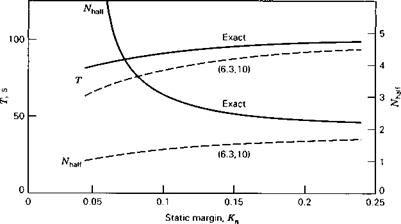EFFECT OF VERTICAL DENSITY GRADIENT
We might expect on physical grounds that the vertical gradient in atmospheric density would have an effect on the phugoid mode. For when the airplane is at the bottom of a cycle and moving fastest it is also in air of greater density and hence would experience an additional increase in lift. It turns out that this effect is appreciable in magnitude. We shall therefore do two things: (1) show how to include this effect in the general equations of motion, and (2) derive a representative order of magnitude of the change in the phugoid period.
The modification to (4.9,18) consists of moving the Д zE equation into the matrix equation and adding some appropriate derivatives to the aerodynamic forces (4.9,17). Since the only possible steady reference state in a vertically stratified atmosphere is horizontal flight, we take 90 = 0. If A denotes the original system matrix, the result is
0 1 о
In (6.5,1) there are three new derivatives with respect to zE• Consider Zz first:
Z = CzpV2S
![]() dZ dZ dp
dZ dZ dp
|
= V[16]S |
dZE Эр dzE
It is reasonable to neglect the variation of Cz with p, and the density varies exponentially with height,2 so that
p = p0eKZ£
and —— = кр (6.5,3)
uZe
where к is constant over a sufficient range of altitude for a linear analysis. It follows that
Xz — kX0 Mz = kM0
From (4.9,6) we get the reference values, leading to

Zz = —mg к X=M= 0
The result is a rather simple elaboration of the original matrix equation. To get an estimate of the order of magnitude of the density gradient effect, it is convenient to return to the Lanchester approximation to the phugoid, and modify it to suit.
In Sec. 6.3 we saw that with this approximation, there is a vertical “spring stiffness” k given by (6.3,3) that governs the period. When the density varies there is a second “stiffness” k’ resulting from the fact that the increased density when the vehicle is below its reference altitude increases the lift, and vice versa. This incremental lift associated with a density change is
ДІ = ClV2S Дp
so that
Using (6.5,3) we get
![]() k’ = kW
k’ = kW
Thus we find that k’ is approximately constant, whereas k from (6.3,3) depends on CWoP, which varies as V~2 for constant weight. The density gradient therefore has its greatest relative effect at high speed. The correction factor for the period, which varies inversely as the square root of the stiffness, is
![]() k y/2 1
k y/2 1
k + k’j ~ (1 + k’/k)U2
so that the period, when there is a density gradient, is T’ = FT. With the given values of k and k’ this becomes
1
F = / kMq i/2 (6.5,8)
V 2SI
in which the principal variable is seen to be the speed. Using a representative value for к of 4.2 X 1СГ5 (6.5,8) gives a reduction in the phugoid period of 18% for the example airplane at 774 fps. This is seen to be a very substantial effect. If the full sys-
|
Figure 6.7 Variation of period and damping of phugoid mode with static margin. |
tern model (6.5,1) is used, comparable effects can be found on the damping of the phugoid as well.












